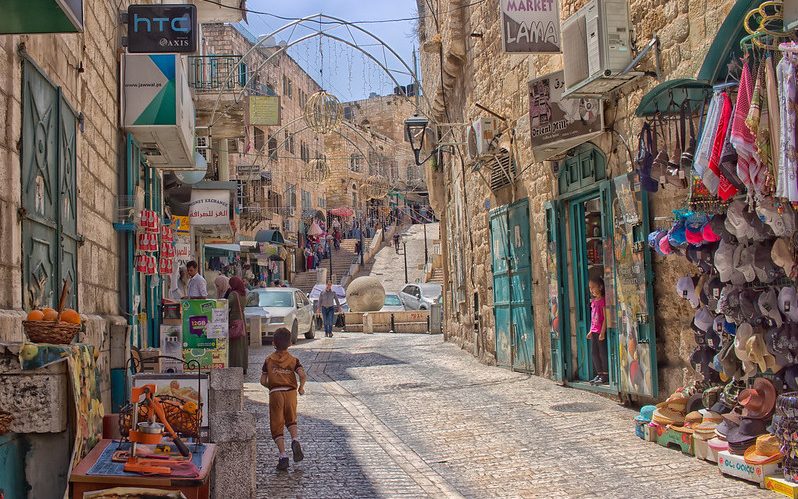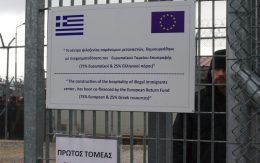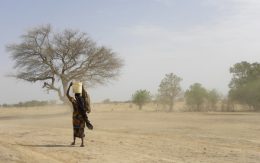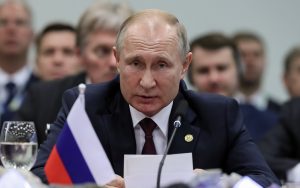This analysis is the fourth article of a six-part series on the Eastern Mediterranean, which provides an overview of the Syrian Civil War, in order to establish an understanding of the current events unfolding in the region. The other parts of this series deal with the historical background, the socio-economic challenges, the Arab Uprising, the Israel-Palestine conflict from 2000-2020, and the “problematic” triangle: Turkey, Cyprus, Greece.
While the entrance of the 21st century signalized a shift from a preexisting unpredictability to a new period of stability for the rest of the international system, a similar development did not occur in the Eastern Mediterranean. As Florence Gaub perfectly summarizes, “[the] Eastern Mediterranean is currently at the epicentre of regional upheaval; the last five years have unfolded in the most unpredictable manner, which raises concerns about the five years to come” (ELIAMEP, 2016: 21). Over the last decades, the region has been the stage of large-scale phenomena accompanied by high political unrest, degradation of socio-economic conditions, and the rise of violence. These shifts have created new security threats, proxy wars, and domestic conflicts that have challenged not only the regional authorities but also the international community. Furthermore, the previously existing “status quo” among the states has been disrupted either by expansionist policies of some political leaders and regional conflicts, or the influence of third states and superpowers. However, what makes the situation in the region especially “inflammable” is the interaction and the deep historical roots of the majority of the regional issues. The combination of these factors constitutes their resolution particularly difficult, hence contributing negatively to their persistence and intensification.
After the presentation of the historical background of the Eastern Mediterranean states in the first part of this series, the forthcoming parts aim to present the issues and events that have determined the development of the region in the last twenty years. Contrary to the first part, the analysis does not focus on the states, but instead, they attempt to shed a light on the present numerous, and complicated issues that the region is confronted with. The rationale behind this decision is that contemporary matters and challenges have transcended the national borders, thus rendering a state-centric study limited and narrow. For this reason, the following articles in this series briefly examine: a) the socio-economic background evolution of the region; b) the 2008 Arab Spring; c) the ongoing Syrian Civil War; d) the Israel-Palestine conflict in the last twenty years; e) the competition of Cyprus and Greece with Turkey. While these are not the only issues the Eastern Mediterranean states are currently facing, they provide a good understanding of the current problems in the region and starting points for further research. This present article will provide an analysis of the Syrian Civil War.
The Syrian Civil War
A careful examination of the epiphenomena of Arab Uprisings in the region of the Middle East and North Africa reveals that the goal of protests was to express the dissatisfaction with the (pre-) existing governments and to demand reforms as well as a change in leadership. Obviously, the outcomes of this transnational phenomenon differentiated from state to state. However, in the case of Syria, the Uprisings set in motion a chain of events with catastrophic consequences. Contrary to the countries examined in the previous parts of this series, the protestors managed to neither overrun the regime nor obtain better human rights and living conditions. Instead, the mix of the dissatisfaction of the Syrian population with the preexisting regional and domestic “cracks” resulted in instability and a civil war that has claimed and destroyed millions of lives, creating downstream consequences for the whole Eastern Mediterranean. This analysis does not focus on the humanitarian dimension of the issue, which is probably the most important aspect, but instead seeks to examine the Syrian Civil War as a “primal mover” for other regional issues and problems.
The causes of the conflict
The escalation of the Arab Spring protests in Syria was the sum of a plethora of issues. Firstly, it is important to consider the geographical and strategic position of Syria. It has historically been formed in the centre of the region of the Middle East, which makes it susceptible to emerging movements, ideologies, and conflicts (Bossi, 2012). An excellent and not so obvious example is that of the US invasion of Iraq in 2003. The reappearance of the US in the region, the pressures from the Bush administration, and the Iran-Saudi Arabian competition (Iran is a main ally of Syria) pushed Syria to withdraw its forces from Lebanon and yield to the US demands. This decision was not well received domestically as it resulted not only in the loss of direct influence over Lebanon, but also “fractured” Assad’s leadership and image, thus resulting in esoteric disputes, and a general crisis in the legitimacy of the regime (Jenkins, 2015). Another instance of regional overflow was the Arab Spring as a movement in Tunisia expanded to Syria and other countries with divergent outcomes. So, there is no denying that Syria’s vulnerable regional position makes it extremely susceptible to ideological “spill-overs” and regional power competitions, both phenomena that increase the prospect of internal destabilization and conflicts.
Secondly, Syria was experiencing a lot of socio-economic problems before the Arab Spring. Like other states in the region, the combination of corruption and authoritarian practices negatively affected the Syrian economy. Despite several moves towards liberalization, privatization, and “opening” of the market, the wealth distribution remained at low levels. While privatization favoured only the “elites”, the provincial Syria (later becoming the centre of the uprising) saw an increase in the living costs and inequality (Ferris & Kirisci, 2016). Moreover, the emergence of other problems, such as population surge and the rise of the rate of unemployment, were demographic time bombs. The final “nail in the coffin” was the drought that began in 2006. According to the United Nations, 75% of Syria’s farms failed, and 86% of the livestock died between 2006–2011 (UN, 2012). The natural phenomenon functioned as a catalyst because it enhanced the preexisting social upheaval and multiplied the severity of the aforesaid issues.
Thirdly, the Assad regime lost its political legitimacy gradually, a crucial element for the survival of a person-centred authoritarian regime. Contrary to his predecessor and father, Bashar Al-Assad had not obtained the right of rule through a manifestation of his military capabilities or “power”. Whilst the shift sparked hope in the Syrian population for reforms, they soon realized that nothing would change. Power remained concentrated in the military and Syria’s powerful intelligence agency, the infamous mukhabarat, which penetrated all spheres of society and halted any civil activism. Apart from that, the 2006 loss of Lebanon and the appearance of serious economic problems further enhanced the displeasure with Assad’s ruling. The preexisting Baathist ideology validating and supporting Assad’s stay in power began to diminish resulting in the corresponding movements and demands for more freedom. Within this context, the Tunisian effect just helped to “speed up” and enhance the existing discontent of the Syrian population (Çakmak & Ustaoğlu, 2015). Fourthly, the social division between the Sunni and Alawite communities in Syria was another important social factor that contributed to the conflict. Despite the colonial root of this phenomenon and famous Syrian tolerance, many Sunnis still resented the fact that a handful of Alawite families monopolized so much power. Thus, a mix of Sunni-led protest movements, Alawite-dominated military, and preexisting detest created all the conditions for the escalation of violence, as it happened (Sluglett, 2016).
How it all started
Everything started in March 2011, when the security forces of President Bashar al-Assad killed several pro-democracy protesters in the southern Syrian city of Deraa. As a result of that, uprisings spread all over the country, demanding Assad’s resignation. Contrary to this Egyptian fellow Hosni Mubarak, Assad did not yield to the “will of the people” but instead, he hardened his position and chose the path of a military resolution. Despite international efforts, such as Kodi Annan’s ceasefire attempts in 2012, the conflict escalated and took new dimensions, from initially armed insurgencies to a full civil war in 2013. The possibility of the collapse of the Assad regime also sparked the interest of regional and international powers, which saw the emerging domestic destabilization as a chance to achieve their longstanding ambitions (Martini, York, & Young, 2013). The war thus saw the “appearance” of several factions: the Syrian Armed Forces and its international allies, a loose alliance of mostly Sunni opposition rebel groups (including the Free Syrian Army), Salafi jihadist groups (including al-Nusra Front), the mixed Kurdish-Arab Syrian Democratic Forces (SDF), and the Islamic State of Iraq and the Levant (ISIL), with numerous external countries either directly involved or providing support to one or another faction (Iran, Russia, Turkey, the United States, as well as others). This embroilment of numerous forces in the conflict has not only hindered its resolution but also facilitated its continuity through military and economic funding. In fact, the Syrian civil war is still in progress. At least twice—in the spring of 2013 and mid-2015—the Assad regime almost collapsed but the interventions of outside players have either sustained the conflict or contributed to its “revitalization”.
The implications of the conflict
There is no denying that the conflict has transcended its original form – the mere demand of the Syrian people for more rights – and has become the root of downstream consequences and new phenomena. Among the most interesting “byproducts” of the civil war is the rise of ISIL and other hardline Islamist groups. Specifically, in 2014, ISIL, a militant Islamist group founded in 1999, managed to establish an Islamic State caliphate, which occupied roughly a third of Syrian territory, with Raqqa as its capital. This unprecedented development caught the international system off guard and especially the US, which responded with the prolongation of its airstrikes and military campaign on August 7 of the same year (Lister, 2015). Still, the US decision was not well received by the extremist terrorist group. In October, ISIS’s Egypt affiliate bombed a Russian airplane, killing 224 people. On November 13, 130 people were killed and more than 300 injured in a series of coordinated attacks in Paris. And in June 2016, a gunman who pledged support to ISIS killed at least four dozen people at a nightclub in Orlando, Florida (Blannin, 2017). Nonetheless, despite the terror and success of its attacks, ISIL was doomed to fail. Surrounded by its enemies and with a small number of resources, the Islamic caliphate had lost 95 percent of its territory by December 2017 and since then it has not accomplished to regain its previous “status”. As a matter of fact, US President Donald Trump declared in December 2018 that the jihadist group was defeated (Vu & Orden, 2019). Yet, as history has shown, it is very difficult to eliminate both the “insurgent elements” and the reasons behind their appearance in the first place. Even if ISIL has been “extinguished”, it will eventually either reappear in a different form (such as Al-Qaeda) or adopt a new “modus operandi”.
What is interesting is that not all states have adopted a negative approach to ISIL. An excellent example is Turkey. Initially, when the jihadist organization came to be, Turkey interpreted it as both a revolution against the colonial western Westphalian sovereignty and positive development for the Ummah community (Capan & Zarakol, 2016). Due to this presupposition, Turkey chose to “sit out” the war against the militant group and Islamic Caliphate. Furthermore, following the failures in Iraq and Libya (2013), Turkey has opposed regional and global powers’ interventions but instead, it has promoted a Turkish mediating role and humanitarian intervention (Parlal Dal, 2017). This policy falls within the context of “New Turkey”, a worldview adopted by AKP in 2014 aiming to expand the country’s global role in the twenty-first century. An excellent example is the Syrian Civil War, where Turkey has pursued a greater role in Syria. While, at the beginning of the conflict, Ankara had adopted a more moderate approach that relied on providing help to Assad, Turkey’s priorities began to shift as the war progressed, from keeping al-Assad in power to restraining the territorial gains of separatist Kurdish groups (Özel & Nasi, 2019). On the one hand, Turkey utilized the group’s existence to target Kurdish militias in Syria, the only ground forces capable of taking on ISIS and win, while it has expanded its influence in the region and occupied Northern Syria with the support of Assad’s regime on the other hand. This new orientation has caused major frictions in relations with the United States and Europe and has led to a strategic rapprochement with Russia (Kobellababa, 2016).
Another country that has been deeply affected by the Syrian Civil War is Lebanon. Traditionally, the state has been perceived as part of “Great Syria” and only recently, in 2008, Syria recognized its sovereignty. Despite the efforts to remain neutral, Lebanon was drawn to the conflict in several manners (Bossi, 2012). Firstly, the country hosts 1.5 million refugees mostly from Syria, and an additional 280,000 refugees from the Palestinian territories. The huge influx of migrants has had two consequences: the growth of animosity and discrimination inside the country, and the fatigue of the Lebanese government that has been confronted with an overwhelming task amid regional and internal problems. Secondly, the fighting from the Syrian Civil War spilt over to Lebanon, as opponents and supporters of the Syrian Arab Republic travelled to Lebanon to fight and attack each other on Lebanese soil. With many of Lebanon’s Sunni Muslims supporting the rebels in Syria and many of Lebanon’s Shi’a Muslims supporting the Syrian government, Lebanon posed a fertile ground for the rise of sectarian violence. From 2011 to 2017, there were thus numerous incidents of killings, unrest, and kidnapping, but still, it did not blow up to a full-on internal conflict. Thirdly, Lebanon had to fight over its territory, when in a joint brigade of Al-Nusra Front and ISIL militants invaded and briefly held the town of Arsal. The clashes between the two sides lasted for two years, until 27 August 2017. The remaining ISIL holdouts in the western Qalamoun agreed to the ceasefire with the Lebanese Army in Lebanon and Hezbollah and the Syrian Army on the Syrian side of the border (Sumpf, Isaila, Najjar, 2016).
Finally, it is impossible not to mention the Syrian refugee crisis in this context. Since the escalation of the Syrian Civil War, millions of Syrians were forced to flee the country to escape the conflict. In fact, in 2016, the UN estimated that from the 22 million population of the pre-war Syrian Arab Republic, 13.5 million were displaced, requiring humanitarian assistance. From these, more than six million (2016) were internally displaced, and around five million (2016) had crossed into other countries, most of them seeking asylum or placed in Syrian refugee camps established in Turkey (3,614,108) Lebanon (929,624), Jordan (662,010), Egypt (131,433), and other countries (UN, 2017). Apart from the mentioned states, the Syrian refugee crisis has had a huge impact on Europe as numerous refugees preferred to cross the Mediterranean to seek a better life. Being at the forefront of the European Union borders, Greece and Cyprus faced the tremendous task of trying to host thousands of people. Considering the internal economic problems and the uniqueness of the phenomenon, it is not surprising that the two countries faced tremendous challenges handling this crisis, and consequently turned to the EU for help (Jonsen & Taylor, 2021). Yet, the magnitude of the issue caused a full-blown European migration crisis that challenged the EU’s unity and foundations but was eventually alleviated (in 2019, the European Commission declared that the migration crisis to have ended). However, the recent advances of the Syrian Army have created new waves of refugees that are utilized by Turkey for political goals, thus prolonging previously existing problems, such as the bad conditions of the refugee camps. If this crisis has achieved something, it is to disrupt the “idealistic” perception of European states and to reveal the bad side of international relations.
Following this analysis of the Syrian Civil war, the forthcoming fifth part of this series will discuss the Israel-Palestine conflict from 2000 to 2020.









Be First to Comment